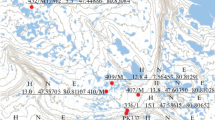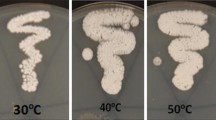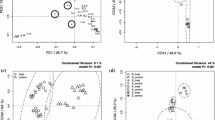Abstract
Microbial communities from soil and groundwater of oil-contaminated sites (Beelitzhof in Berlin-Nikolassee and the former Pintsch site in Hanau, both in Germany) were characterized by description of the physiological potential of arbitrary samples of 48 aerobic heterotrophic bacterial isolates. It was demonstrated that the sum of metabolic abilities, presented as a percentage of substrate-degrading microorganisms in a sample, is both site specific and reproducible. The percentage of hydrocarbon-degrading microorganisms in the communities was most strongly influenced by the diversity and amount of carbon supply (whereas after addition of mineral salts, total cell counts increased). For example, in groundwater of the waste oil-contaminated Pintsch site, only the accessible short-chain alkanes up to dodecane could be metabolized. After dosing with hydrogen peroxide, long-chain alkane-degrading bacteria were found in significant amounts among the predominant microorganisms, which was apparently due to a solubilization effect that brought the longer alkanes (and their degraders) into the groundwater. Because the addition of precultured organisms to a soil-composting windrow had no effect on the degradation pattern of its microbiota, the carbon sources available probably determined whether allochthonous bacteria would become indigenous. Although the physiological potentials of the individual bacteria complemented each other and thus determined the distinctive profile characteristic of the microbial community, the individual members could differ in their metabolic abilities, as was shown by the distribution of positive test results in different samples, and they could also differ in their taxonomic status. Evidently, the taxonomic status of the bacteria did not determine their activities: Strains of the same species showed different degradation abilities for hydrocarbon substrates. However, the taxonomic status of isolates seemed to be highly dependent on the physicochemical factors of a site (soil structure, water capacity, etc.).
Similar content being viewed by others
References
Austin B, Calomiris JJ, Walker JD, Colwell RR (1977) Numerical taxonomy and ecology of petroleum-degrading bacteria. Appl Environ Microbiol 34:60–68
Becker PM (1993) Miniaturisierte Tests zur Bestimmung des Kohlenwasserstoff-Abbaupotentials mikrobieller Biozönosen. Dr.-Ing. thesis, Technical University of Berlin. In: Dott W, Rüden H (eds) Veröffentlichungen aus dem Fachgebiet Hygiene der TU Berlin und dem Institut für Hygiene der FU Berlin, vol 12. Universitätsbibliothek, Abt. Publikationen Berlin.
Dean-Ross D (1989) Bacterial abundance and activity in hazardous waste- contaminated soil. Bull Environ Contam Toxicol 43:511–517
Eickelboom DH (1975) Filamentous organisms in activated sludge. Water Res 9:365–388
Emerson E (1943) The condensation of aminoantipyrine. II. A new color test for phenolic compounds. J Org Chem 8:417–428
Focht DD (1988) Performance of biodegradative microorganisms in soil: xenobiotic chemicals as unexploited metabolic niches. In: Omenn GS (ed) Environmental biotechnology—reducing risks from environmental chemicals through biotechnology. Plenum Press, New York, pp 15–30
Folin O, Denis W (1915) A colorimetric method for the determination of phenols (and phenol derivatives) in urine. J Biol Chem 22:305–308
Grange JM (1974) A micromethod for the study of n-paraffin utilization by Mycobacteria. J Appl Bacteriol 37:465–468
Harayama S, Timmis KN (1989) Catabolism of aromatic hydrocarbons by Pseudomonas. In: Hopwood DA, Chater KF (eds) Genetics of bacterial diversity. Academic Press, London, pp 152–174
Hodgson DA (1989) Bacterial diversity: the range of interesting things that bacteria do. In: Hopwood DA, Chater KF (eds) Genetics of bacterial diversity. Academic Press, London, pp 3–22
Jensen V (1976) Bacterial flora of soil after application of oily waste. Oikos 26:152–158
Kampfer P, Friedrich L, Becker PM, Dott W (1992) Beeinflussung der Bodenpopulation durch Einsatz vorgezüchteter Mikroorganismen bei der Mietentechnologie. In: Behrens D, Wiesner J (eds) Mikrobiologische Reinigung von Böden: Beiträge des 9. Dechema Fachgesprächs Umweltschutz, 27, 28 February 1991, Frankfurt. 1. Bericht des interdisziplindren Arbeitskreises des Dechema “Umweltbiotechnologie—Boden.” Dechema e.V, Frankfurt, Germany, pp 320–325
Kampfer P, Steiof M, Becker PM, Dott W (1993) Characterization of chemoheterotrophic bacteria associated with the in-situ bioremedation of a waste oil-contaminated site. Microb Ecol 26: 161–188
Kämpfer P, Steiof M, Dott W (1991) Microbiological characterization of a fuel oil contaminated site including numerical identification of heterotrophic water and soil bacteria. Microb Ecol 21:227–251
Lode A (1986) Changes in the bacterial community after application of oily sludge to soil. Appl Microbiol Biotechnol 25:295–299
MacRae IC (1989) Microbial metabolism of pesticides and structurally related compounds. Rev Environ Contam Toxicol 109:2–87
McAuliffe C (1969) Solubility in water of normal C9 and C10 alkane hydrocarbons. Science 163:478–479
Pfennig N, Lippert KD (1966) Über das Vitamin B12-Bedürfnis phototropher Schwefelbakterien. Arch Mikrobiol 55:245–256
Reasoner DJ, Geldreich EE (1985) A new medium for the enumeration and subculture of bacteria from potable water. Appl Environ Microbiol 49:1–7
Ridgeway HE, Safarik J, Phipps D, Carl P, Clark D (1990) Identification and catabolic activity of well derived gasoline-degrading bacteria from a contaminated aquifer. Appl Environ Microbiol 56:3565–3575
Riss A, Barenschee ER, Helmling O, Ripper P (1991) Einsatz von Wasserstoffperoxid zum mikrobiologischen Kohlenwasserstoffabbau: Labor-und Feldversuche in-situ. gwf-Wasser/Abwasser 132:115–126
Rosenberg E (1992) The hydrocarbon-oxidizing bacteria. In: Balows A, Trüper HG, Dworkin M, Harder W, Schleifer K-H (eds) The prokaryotes: a handbook on the biology of bacteria: ecophysiology, isolation, identification, applications, 2nd ed., vol. 1. Springer-Verlag, Berlin, Heidelberg, New York, pp 446–459
Roy I, Mishra AK, Ray AK (1991) Alkane and crude oil degrading bacteria from the petroliferous soil of India. In: Hinchee RE, Olfenbuttel RF (eds) In situ bioreclamation—applications and investigations for hydrocarbon and contaminated site remediation. Butterworth-Heinemann, Boston, pp 420–428
Schumb WC, Satterfield CN, Wentworth RL (1955) Hydrogen peroxide. ACS Monograph Series. Reinhold Publishing Corporation, New York
Schütt C (1990) Plasmids and their role in natural aquatic bacterial communities. In: Overbeck J, Chróst RJ (eds) Aquatic microbial ecology. Springer-Verlag, New York, pp 160–183
Song H-G, Bartha R (1990) Effect of jet fuel spills on the microbial community of soil. Appl Environ Microbiol 56:646–651
Stirling LA, Watkinson RJ, Higgins IJ (1977) Microbial metabolism of alicyclic hydrocarbons: isolation and properties of a cyclohexane-degrading bacterium. J Gen Microbiol 99:119–125
Trower MK, Buckland RM, Higgins R, Griffin M (1985) Isolation and characterization of a cyclohexane metabolizing Xanthobacter sp. Appl Environ Microbiol 49:1282–1289
Young JPW (1989) The population genetics of bacteria. In: Hopwood DA, Chater KF (eds) Genetics of bacterial diversity. Academic Press, London, pp 417–438
Williams PA (1982) Genetic interactions between mixed microbial populations. Phil Trans R Soc Lond B 297:631–639
Author information
Authors and Affiliations
Additional information
Correspondence to: P.M. Becker
Rights and permissions
About this article
Cite this article
Becker, P.M., Dott, W. Functional analysis of communities of aerobic heterotrophic bacteria from hydrocarbon-contaminated sites. Microb Ecol 30, 285–296 (1995). https://doi.org/10.1007/BF00171935
Received:
Revised:
Issue Date:
DOI: https://doi.org/10.1007/BF00171935




